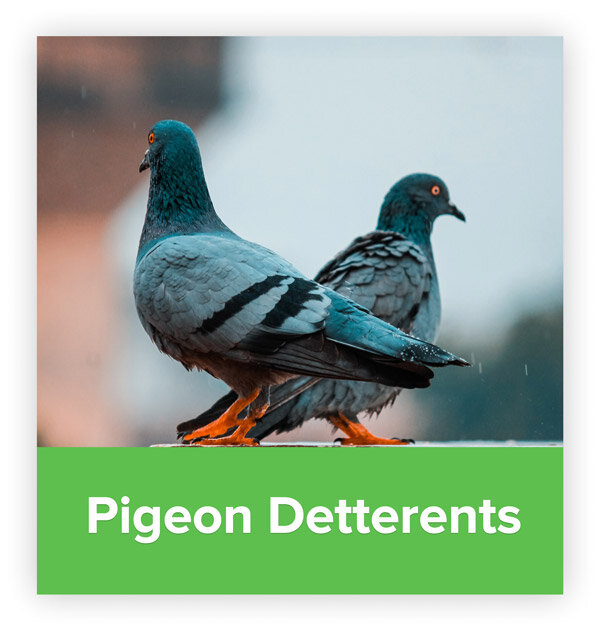Pigeon Deterrents - Effigies, Sonic Emitters, Propane Cannons
Written by Erick Wolf
Before determining which control methods are appropriate to get rid of pigeons for a given location, a thorough site evaluation is necessary to determine the specific techniques and products suitable for a given set of circumstances and conditions. Depending on the site, a combination of tools may be needed to realize the desired outcome.
Pigeon Pressure
“Pigeon pressure”, represents the bond that the pigeon flock has to the site or area which they call home. The amount of “pressure” at a given location will determine how easy or difficult it will be to achieve relief from the issues that pigeons cause. Low-pressure sites are far easier to resolve than higher-pressure sites. Deterrents, which are defined as harassment or repelling techniques, can sometimes be enough of a control method for low to moderate pressure scenarios.
It should be noted that even when effective, all deterrents will simply move the birds to the next best place on your structure or to an adjacent structure. That may or may not resolve the pigeon problem, and why it is so important to evaluate the site appropriately.
The following table provides an overview of common deterrents for pigeon control. We will provide a more thorough description of each in the following article.
| Method/Product | Best Used For | Advantages | Disadvantages |
| Deterrents | |||
| Sonic and ultrasonic emitters | Aural harassment | Can be used in larger areas where exclusion is not practical | Birds acclimate to the sounds |
| Effigies – plastic owl, rubber snake | Visual harassment | Can be effective short term | Birds acclimate to effigies |
| Reflected and direct light sources | Visual harassment | Can be effective long-term under appropriate conditions | Costs have a wide range; from shiny pie plates or CD’s to industrial lasers |
| Propane cannon | Harassment | Tangible and immediate effects | Birds acclimate and eventually ignore the noise; not suitable for urbanized areas |
| Trained raptors | Harassment with predators | Pigeons will flee raptors | Pigeons come right back when the birds of prey go home |
Are deterrents an effective form of pigeon control?
The short answer to this question is yes and no. Consider that under certain conditions, even a plastic owl can be effective, so conditions and circumstances at the location under consideration is paramount to judging the eventual performance of a pigeon repelling technique prior to installation.
Before going any further, however, it should be made clear that pigeons habituate to sights and sounds. In other words, they become accustomed to sounds they hear and things they see that do not represent an actual threat.
Do audible deterrents represent an effective deterrent for pigeons?
Starting with sounds, pigeons can hear in the same audible range that people do. Therefore, if you are unable to hear the ultrasonics from an ultrasonic device, they cannot hear it either.
In addition to the ultrasonic devices, there are a myriad of different devices that mimic the sounds of pigeon predators – hawks, owls, falcons, etc. Theoretically, it makes some sense – pigeons have an instinctive fear of raptors. Unfortunately, in this case the pigeons also become accustomed to the sounds of a predator and eventually ignore the sounds without the presence of an actual raptor.
In the extreme case, a loud propane cannon can be deployed but this is not appropriate for any kind of urban site. These noise makers are used mostly in agricultural scenarios or airports.
Are effigies, like a scarecrow, effective in deterring pigeons?
We all know effigies from the most common one – a scarecrow. In the world of pigeons, the most common effigy is a plastic owl. Unfortunately, while they may provide some short-term relief, effigies have little or no long-term effect on a pigeon’s behavior. The same holds true for all other effigies that are recommended for pigeons.
How effective are light reflectors or direct light sources for pigeons?
A light source, either direct or reflected, under the appropriate circumstances can represent an effective repellent technique for pigeons. Birds are disoriented by direct or reflected light. Therefore, an item as simple as an aluminum pie plate or reflective CD can be effective in repelling pigeons.
There are more technologically advanced solutions to this method ranging from rotating reflectors all the way up to an industrial laser which can be mounted on a rooftop or at an airport. Professional installation is required for these devices.
Are trained raptors useful to get rid of my pigeons?
A very natural option for repelling pigeons in large areas is to employ trained raptors. Pigeons have an instinct to avoid these birds since they often represent “lunch” for the predator. Raptors used for this activity are commonly a trained hawk or falcon together with a specially trained handler.
The problem is that the effect of the raptor is mostly temporary. The pigeons will quickly return once the raptor is gone. The technique is ideally suited for a larger area, like an airport, which can afford to rent raptors and their handlers for days at a time. They are also useful for large sporting events, like a tennis tournament where relatively short-term use of the birds is needed.
Other than a trained raptor, your best bet is to encourage real raptors to move into your neighborhood. Check with your state department of agriculture for recommendations on structures that will encourage raptor nesting. Installation of an owl box is a good example.
Summary
In summary, common deterrents can be effective in low to moderate “pigeon pressure” circumstances. Outlandish claims of efficacy should be considered with skepticism.
Learn more about pigeon control alternatives:
- Pigeon Culling Methods: Poisoning, Shooting, Traps and Raptors
- Reducing Pigeon Reproduction: A Long-Term Solution for Pigeon Control
- Physical Exclusion of Pigeons – Spikes, Wires, Nets and Slides
- Pigeon Deterrents - Effigies, Sonic Emitters, Propane cannon
- Bird Netting: Everything you Should Know





